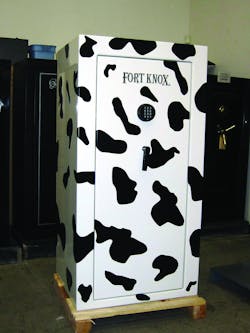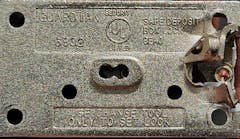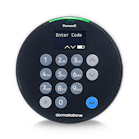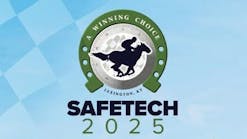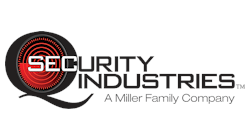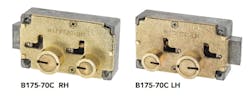In the past, burglary safes were stashed in back rooms, hidden from view. Floor safes were installed in garages or in some back corner of a home office or closet, covered by a rug or carpet. In those days, safes were kept in dark out-of-the-way places where no criminal would even consider looking. The safest safes were considered to be the ones that were not to be seen.
Today, this hidden safe concept has been smashed to pieces. Safes can now be considered by many as part of the home’s furnishings, a unique way to express one’s personality. The front cover image of one recent safe brochure shows a large safe in the public area of a person’s home.
Safes are available in just about every size and configuration imaginable, ranging from small containers that would fit into an end table, to horizontal cabinet safes that looks like a chest at the foot of a bed, to large gun safes that weigh several tons and are the focal point of an entire wall.
The purpose for owning a safe determines both the type and size of the safe. If the safe is only for securing valuables, coin collections, cash and jewelry, then a burglary type container can be recommended. If the safe will be used to protect papers, photographs and non-metallic mementos, then a fire safe can be recommended. If the safe is going to protect papers and computer disks, than a fire safe having computer media protection is required.
There are safes specifically designed for computer media. Media protection is also available as a separate unit that is designed to keep the temperature (U.L. 125°F) and humidity to a specific level to ensure the safety of computer storage equipment.
If the safe will be used to store and protect firearms, than a gun safe is recommended. Gun safes come in a variety of sizes that are indicated by the number of rifles/shot guns that can be stored within an individual rack slot.
If the actual purpose of the safe is uncertain or if the safe will be used for both documents and valuables, then a burglary/fire or a burglary/fire gun safe can be recommended in order to cover the options.
Gun safes are larger safes; at a minimum, they are longer than a rifle. Prices range from a few hundred dollars to many thousands. The better the burglary protection, the thicker the steel on the door and walls will be.
Safes are available having no burglary rating to Residential Security Containers (RSC) to TL-15 and TL-30 safes. Fire protection in safes can be non-existent to 30-minute protection up to two hours or more at specific temperature fires. For most safes, the bigger, the heavier the safe, the better the level of burglary protection. The same generally follows for fire protection in safes.
Most safe customers do not know how much room they need to store their present and future possessions. One safe manufacturer estimates that more than 90 percent of purchasers outgrow their safes within a few years. This can be an important selling point. Ask your customers about their needs in the near and not so near future.
Larger safes provide more customization options and features. The exterior of the safe can be ordered with a gloss finish or a custom color(s). The combination lock can be an electronic pushbutton or a biometric. The handle can have a three- or five-spoke spinner or a ship’s wheel design. On higher end safes, 14Kor 24K gold plate or black chrome finishes are available for the safe lock and the handle.
If the safe has external hinges, consider installing finial onto each of the hinges.
A relatively inexpensive way to dress up a safe is by using a Mylar silhouette decal to give the safe a personal touch. A number of decal styles are available; most common are wildlife scenes. A standard silhouette is approximately 14 to 16 inches wide.
A hand painted mural is the ultimate personal touch for your customer’s safe. A custom mural can be painted from a photograph, picture, etc.
Depending upon the customer’s needs, the interior of the safe can have added protection. For example, a stainless steel liner option can be installed on the interior of the body and the door to resist torch attacks.
A tempered glass or Plexiglas inside panel exposing the boltwork has become a desired option. Fort Knox Legend Series safes are equipped with tempered glass interior panel that shows the patented Rack & Pinion multi-gear locking mechanism. Each locking bolt operates independently of one another, with up to 55 rack and pinion gears driving up to 28 1-1/2” locking bolts. For the example Fort Knox Legend, the tempered glass panel covers the nickel plated multi-gear locking mechanism.
For a functional inside panel, safe manufacturers offer a variety of door mounted holster systems which range from individual holsters and pockets to full fabric panels that are available for the different size safes. The larger the safe, the more holsters and pockets it can have.
Liberty Safes offers the Accessory Fabric Door Panel that has quick draw holsters, zip pockets, choke tube holders and Cool Pockets for documents. This panel is standard on Lincoln safes and above, optional on Franklin Series Safes.
The inside of most safes can be configured in an almost infinite number of ways. Shelves, drawers and cabinets are optional or standard features. In many gun safes, cutout shelves enable rifles to be positioned in one or more layouts. Cover plates convert the cutout shelves to standard shelving. Storage cabinets and individual drawers are commonly available. Velvet lined jewelry drawers come in various sizes. Layout options vary by the safes’ internal dimensions and if the customer wants custom or standard components.
American Security Products (AMSEC) has introduced two- and four-drawer interior wood cabinets to store jewelry, coins and papers in a letter-sized file. These solid maple drawer fronts and maple veneer storage cabinets are finished in a honey maple stain. These cabinets are a standard safe size and can be the interior or a portion of the safe’s interior.
The four-drawer chest has red felt-lined tray drawers with organizers for content presentation. The top drawer has two organizers, a ring-holder compartment with two open spaces and a seven-compartment organizer with three long spaces and four small spaces. The second drawer organizer has three long spaces. The third drawer has a nine=compartment watch organizer. The bottom drawer is open for easy access of larger items. The four-drawer chest weighs 32 pounds.
The two-drawer chest has one red felt-lined tray drawer and the lower drawer can also be a letter size file drawer to protect important papers. The two-drawer chest weighs 37 pounds. Exterior dimensions of the two- and four-drawer models are 16-3/4” high by 16” wide by 15-3/4” deep. Both drawer options have heavy duty, ball-bearing drawer guides.
Some safe manufacturers have as standard or optional a partial mirrored rear wall. This improves the visibility of items in the upper shelves of the safe. Fluorescent lighting is another feature to add illumination when the door is opened. Safe manufacturers offer a variety of fluorescent bulbs in various lengths, depending upon the size of the safe and the positioning of the bulbs. A 120 VAC outlet in the safe provides power for lighting as well as an electric dehumidifier.
In hot, humid areas of the United States, , a de-humidifier is recommended to absorb unwanted moisture inside the safe. For many years, desiccant was recommended for safes as no power was required to control the humidity with the safe. Desiccant is a moisture absorbing substance that can be dried out many times and reused.
Electric Dehumidifiers control the temperature inside safe to protect metal items from rust and mold. EVA-Dry Dehumidifiers are cordless units that reduce moisture by absorbing the humidity inside the safe. The unit is placed on any shelf. A color-coded readout indicates the amount of moisture absorbed. The EVA-Dry Dehumidifiers must be plugged into an outlet overnight in order to dry out.
The final touch, although not usually visible, is to install an anchoring kit when the safe has been delivered. The anchoring kit secures the safe to the floor. Most safes have pre drilled holes.
For more information, see the following partial list of safe manufacturers:
• American Security Products: www.amsecusa.com
• Cannon Safe Inc.: www.cannonsafe.com
• Fort Knox Security Products: www.FTKNOX.com
• Gardall Safe Corp.: www.gardall.com
• Inkas Safe Manufacturing: www.inkas.ca
• Liberty Safe: www.libertysafe.com
• Protex Safe Co.: www.protexsafe.com
• Winchester Safes: www.winchestersafes.com
